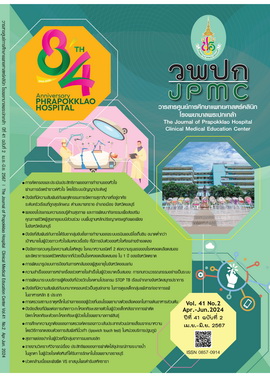Weaning of Mechanical Ventilator Success in Patients with Brain Injuries: A Systematic Review
Main Article Content
Abstract
BACKGROUND: The use of invasive mechanical ventilation in patients brain injuries helps treat life-threatening conditions. Long-term usage of the invasive mechanical ventilator, however, will result in poor outcomes such as ventilator-associated pneumonia (VAP).
OBJECTIVES: To summarize knowledge regarding successful weaning from invasive mechanical ventilation in patients with brain injuries.
METHODS: The systematic review of literature had a sample consisting of research conducted on successful weaning from mechanical ventilation in patients with brain injuries by searching for keywords according to the PICO principle from 2018–2023. The research tools included an appraisal form and a data extract form developed by the Joanna Briggs Institute with a critical appraisal checklist for descriptive research form. The results yielded 7 studies meeting the inclusion criteria, for which the results cannot be compared. Therefore, a content summary was used to summarize the knowledge obtained from the systematic literature review.
RESULTS: The results showed that weaning success in patients with brain injuries placed on an invasive mechanical ventilator was evaluated based on level of consciousness, ability to cough, swallow, and reductions in the quantity of sputum along with daily assessment of readiness for weaning from mechanical ventilation, self-breathing exercises, assessment of readiness to wean, and record of weaning.
CONCLUSIONS: The conclusions that correspond with the research analyzing weaning success in patients with brain injuries placed on an invasive mechanical ventilator are that weaning reduces the duration of mechanical ventilation, length of stay in the ICU or hospital, and pulmonary complications.
Article Details

This work is licensed under a Creative Commons Attribution-NonCommercial-NoDerivatives 4.0 International License.
References
Cinotti R, Bouras M, Roquilly A, Asehnoune K. Management and weaning from mechanical ventilation in neurologic patients. Ann Transl Med [Internet]. 2018 [cited 2023 Dec 12];6(19):381. Available from: https://atm.amegroups.org/article/view/20801/pdf
Shi ZH, Jonkman AH, Tuinman PR, Chen GQ, Xu M, Yang YL, et al. Role of a successful spontaneous breathing trial in ventilator liberation in brain-injured patients. Ann Transl Med [internet]. 2021 [cited 2023 Dec 13];9(7):548.Available from: https://atm.amegroups.org/article/view/66754/pdf
Bureau C, Demoule A. Weaning from mechanical ventilation in neurocritical care. Rev Neurol (Paris) 2022;178:111-20.
da Silva AR, Novais MCM, Neto MG, Correia HF. Predictors of extubation failure in neurocritical patients: A systematic review. Aust Crit Care 2023;36:285-91.
Battaglini D, SiwickaGieroba D, Brunetti I, Patroniti N, Bonatti G, Rocco PRM, et al. Mechanical ventilation in neurocritical care setting: a clinical approach. Best Pract Res Clin Anaesthesiol 2021;35:207-20.
Robba C, Poole D, McNett M, Asehnoune K, Bösel J, Bruder N, et al. Mechanical ventilation in patients with acute brain injury: recommendations of the European Society of Intensive Care Medicine consensus. Intensive Care Med 2020;46:2397-2410.
Robba C, Citerio G, Taccone FS, Galimberti S, Rebora P, Vargiolu A, et al. Multicentre observational study on practice of ventilation in brain injured patients: the VENTIBRAIN study protocol. BMJ Open [Internet]. 2021 [cited 2024 Jan 2];11(8):e047100. Available from: https://www.ncbi.nlm.nih.gov/pmc/articles/PMC8359464/pdf/bmjopen-2020-047100.pdf
Chaiyafong S, Kenthongdee W, Tongtem E. The development of clinical nursing practice guideline for weaning from mechanical ventilation in patients with brain surgery, surgical intensive care unit, Loei hospital. Journal of Nursing Division 2022;49(1):49-63.
Khalil NS, Mohamed WY, Sharkawy MAM. Patients’ weaning from mechanical ventilation: complete versus incomplete ventilator bundle implementation. IJANS 2018;8:28-32.
Belenguer-Muncharaz A, Díaz-Tormo C, Granero-Gasamans E, Mateu-Campos ML. Protocol-directed weaning versus conventional weaning from mechanical ventilation for neurocritical patients in an intensive care unit: a nonrandomized quasi experimental study. Crit Care Sci 2023;35:44-56.
Bösel J, Rabinstein AA. Extubation failure in patients with acute brain injury: a major problem still awaiting a solution. Intensive Care Med 2022;48:1611-3.
Aromataris E, Lockwood C, Porritt K, Pilla B, Jordan Z, editors. JBI Manual for Evidence Synthesis [Internet]. 2020 [cited 2023 Dec 26]. Available from: https://jbi-global-wiki.refined.site/space/MANUAL
Kummatid A, Markrat M. Using the systematic review to provide a complete summary on a research question in evidence based practice: a 3-step method. The Southern College Network Journal of Nursing and Public Health 2016;3(3):246-59.
Wahlster S, Sharma M, Taran S, Town JA, Stevens RD, Cinotti R, et al. Utilization of mechanical power and associations with clinical outcomes in brain injured patients: a secondary analysis of the extubation strategies in neuro-intensive care unit patients and associations with outcome (ENIO) trial. Crit Care [Internet]. 2023[cited 2024 Jan 1];27(1):156.Available from: https://www.ncbi.nlm.nih.gov/pmc/articles/PMC10120226/pdf/13054_2023_Article_4410.pdf
Huang HY, Lee CS, Chiu TH, Chen HH, Chan LY, Chang CJ, et al. Clinical outcomes and prognostic factors for prolonged mechanical ventilation in patients with acute stroke and brain trauma. J Formos Med Assoc 2022;121(1 Pt 1):162-9.
Page M J, McKenzie JE, Bossuyt PM, Boutron I, Hoffmann TC, Mulrow CD, et al. The PRISMA 2020 statement: an updated guideline for reporting systematic reviews. BMJ [Internet]. 2021 [cited 2024 Jan 1];10:1-11. Available from: https://www.bmj.com/content/bmj/372/bmj.n71.full.pdf

